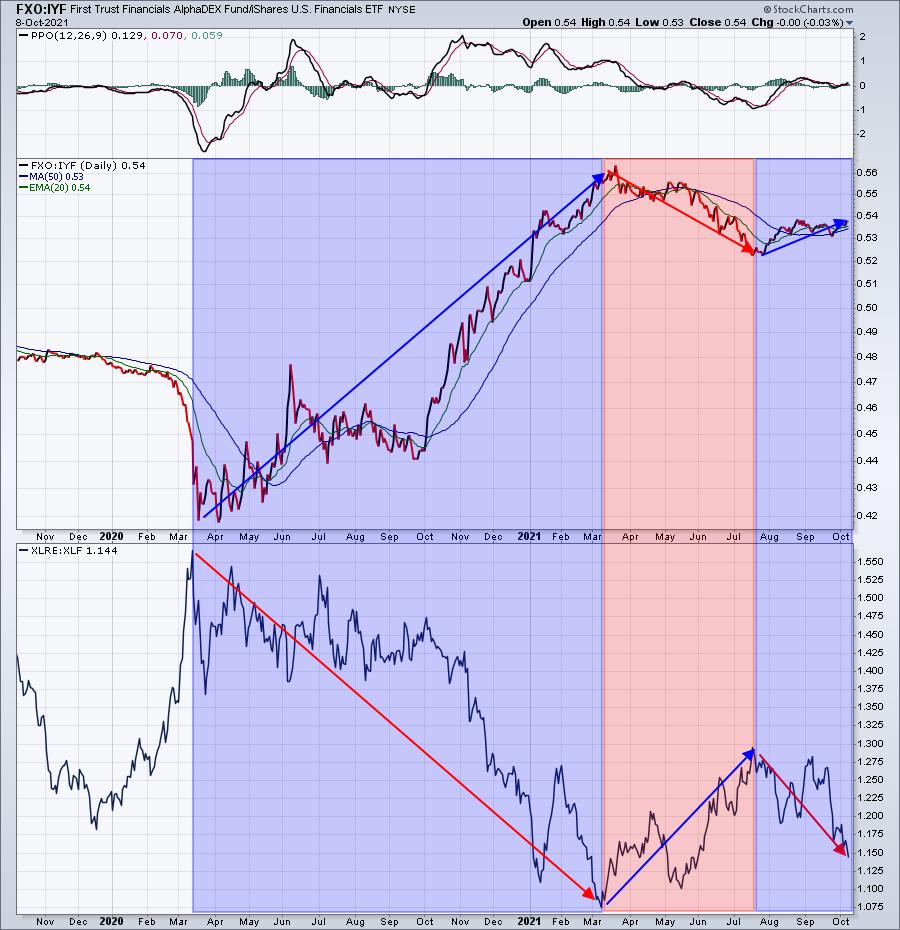There's an assumption that ETFs are well-diversified and that buying leading ETFs will be profitable. That may turn out to be true, but it may not. ETFs are no better than the stocks they own and they could be extremely risky depending on the weighting of their top holdings. Many ETFs own over the counter (OTC) stocks that have little liquidity. That always bothers me. If I don't want to own individual stocks because of their limited liquidity, would I want to own ETFs that own such stocks? I don't think so.
In this article, I simply want to break down two leading financial ETFs that might seem similar, but, in reality, they aren't. From the SCTR Reports area of StockCharts.com, I typed in "financials" in the search box and sorted the ETFs by "SCTR". Two ETFs, FXO and IYF both appeared, had identical SCTR scores of 94, and both traded more than 100,000 shares, so liquidity isn't an issue for either.
Are they the same, or interchangeable? I don't think so and here's why.
If you look at the sector breakdown of FXO, financial services represent 99.68% of the entire ETF. The IYF, however, is broken down as follows:
- Financial services: 79%
- Real estate: 21%
Maybe that doesn't bother you, but when the real estate group (XLRE) underperforms financials (XLF), it's going be reflected in the IYF underperforming the FXO. The following price relative chart shows the FXO:IYF ratio rising when real estate struggles relative to financials. Check this out:

Both of these ETFs look like financial ETFs. Their names would suggest that:
- First Trust Financials AlphaDEX Fund (FXO)
- iShares U.S. Financials ETF (IYF)
I don't see real estate in IYF name at all. Without doing a little bit of research, how would you ever know that 21% of your investment is going into real estate. For me, that would make a HUGE difference, because in a bull market, I want my money invested in aggressive areas of the market, not defensive. Not knowing the difference between these two ETFs would have cost me money.
This is just one difference in building a portfolio that you absolutely should be aware of. Knowing the Top 10 Holdings and how much that represents in each ETF is an example of assessing risk as diversification, or lack thereof, may be a huge factor for you as well. Our mantra at EarningsBeats.com, especially as it relates to ETFs, is Know What You Own!
At 11:00am ET, I will be hosting our "Sneak Preview: Model ETF Portfolio", where I'll be discussing our strategies at EarningsBeats.com in designing our Model ETF Portfolio. We use a dynamic interactive tool, our "ETF Analyzer" to help us construct ETF portfolios with EXACTLY the sector representation we're looking for. It's simple to use and can help you build a portfolio that's right for you. This is a FREE event, so if you're reading this before 11:30am ET, feel free to join us using the following room link:
https://earningsbeats.zoom.us/j/83299713065
If you're not already a subscriber to our FREE EB Digest newsletter, we'll add you using your email address provided. If you're reading this after 11:30am ET or so, you can CLICK HERE to subscribe to our EB Digest newsletter (no credit card required) and we'll be sure to send out a copy of the recording so that you can listen at your leisure!
Happy trading!
Tom






